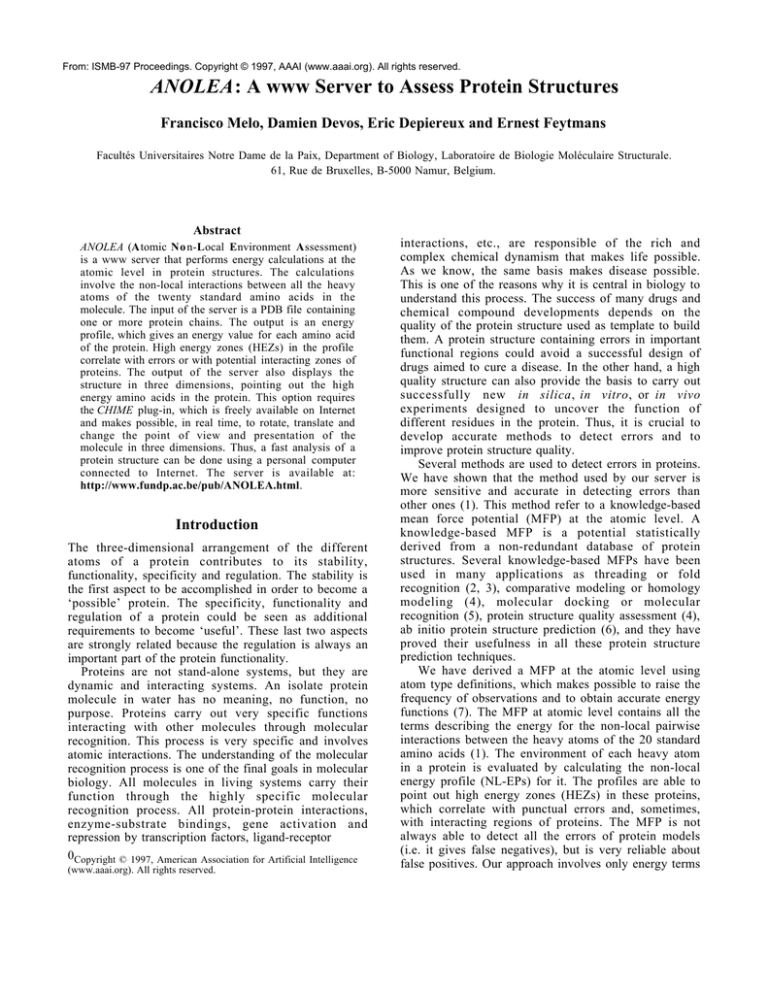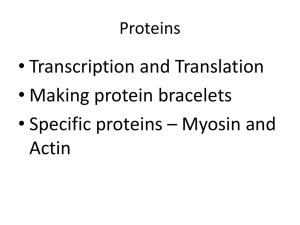
From: ISMB-97 Proceedings. Copyright © 1997, AAAI (www.aaai.org). All rights reserved.
ANOLEA: A www Server to Assess Protein Structures
Francisco Melo, Damien Devos, Eric Depiereux and Ernest Feytmans
Facultés Universitaires Notre Dame de la Paix, Department of Biology, Laboratoire de Biologie Moléculaire Structurale.
61, Rue de Bruxelles, B-5000 Namur, Belgium.
Abstract
ANOLEA (Atomic No n-Local Environment Assessment)
is a www server that performs energy calculations at the
atomic level in protein structures. The calculations
involve the non-local interactions between all the heavy
atoms of the twenty standard amino acids in the
molecule. The input of the server is a PDB file containing
one or more protein chains. The output is an energy
profile, which gives an energy value for each amino acid
of the protein. High energy zones (HEZs) in the profile
correlate with errors or with potential interacting zones of
proteins. The output of the server also displays the
structure in three dimensions, pointing out the high
energy amino acids in the protein. This option requires
the CHIME plug-in, which is freely available on Internet
and makes possible, in real time, to rotate, translate and
change the point of view and presentation of the
molecule in three dimensions. Thus, a fast analysis of a
protein structure can be done using a personal computer
connected to Internet. The server is available at:
http://www.fundp.ac.be/pub/ANOLEA.html.
Introduction
The three-dimensional arrangement of the different
atoms of a protein contributes to its stability,
functionality, specificity and regulation. The stability is
the first aspect to be accomplished in order to become a
‘possible’ protein. The specificity, functionality and
regulation of a protein could be seen as additional
requirements to become ‘useful’. These last two aspects
are strongly related because the regulation is always an
important part of the protein functionality.
Proteins are not stand-alone systems, but they are
dynamic and interacting systems. An isolate protein
molecule in water has no meaning, no function, no
purpose. Proteins carry out very specific functions
interacting with other molecules through molecular
recognition. This process is very specific and involves
atomic interactions. The understanding of the molecular
recognition process is one of the final goals in molecular
biology. All molecules in living systems carry their
function through the highly specific molecular
recognition process. All protein-protein interactions,
enzyme-substrate bindings, gene activation and
repression by transcription factors, ligand-receptor
0Copyright © 1997, American Association for Artificial Intelligence
(www.aaai.org). All rights reserved.
interactions, etc., are responsible of the rich and
complex chemical dynamism that makes life possible.
As we know, the same basis makes disease possible.
This is one of the reasons why it is central in biology to
understand this process. The success of many drugs and
chemical compound developments depends on the
quality of the protein structure used as template to build
them. A protein structure containing errors in important
functional regions could avoid a successful design of
drugs aimed to cure a disease. In the other hand, a high
quality structure can also provide the basis to carry out
successfully new in silica, in vitro, or in vivo
experiments designed to uncover the function of
different residues in the protein. Thus, it is crucial to
develop accurate methods to detect errors and to
improve protein structure quality.
Several methods are used to detect errors in proteins.
We have shown that the method used by our server is
more sensitive and accurate in detecting errors than
other ones (1). This method refer to a knowledge-based
mean force potential (MFP) at the atomic level. A
knowledge-based MFP is a potential statistically
derived from a non-redundant database of protein
structures. Several knowledge-based MFPs have been
used in many applications as threading or fold
recognition (2, 3), comparative modeling or homology
modeling (4), molecular docking or molecular
recognition (5), protein structure quality assessment (4),
ab initio protein structure prediction (6), and they have
proved their usefulness in all these protein structure
prediction techniques.
We have derived a MFP at the atomic level using
atom type definitions, which makes possible to raise the
frequency of observations and to obtain accurate energy
functions (7). The MFP at atomic level contains all the
terms describing the energy for the non-local pairwise
interactions between the heavy atoms of the 20 standard
amino acids (1). The environment of each heavy atom
in a protein is evaluated by calculating the non-local
energy profile (NL-EPs) for it. The profiles are able to
point out high energy zones (HEZs) in these proteins,
which correlate with punctual errors and, sometimes,
with interacting regions of proteins. The MFP is not
always able to detect all the errors of protein models
(i.e. it gives false negatives), but is very reliable about
false positives. Our approach involves only energy terms
without consideration of any other parameter. Here we
describe the current implementation of our www server
and we also give some examples of its utility in
molecular biology.
Methods
We defined a total number of 40 different atom types for
all the heavy atoms of the 20 amino acids (7). The atom
type definition is based on its connectivity, chemical
nature and location level (side-chain or backbone). The
MFP was calculated from a set of 147 protein chains
obtained from the PDB (8) with complete atomic
coordinates, excluding all the proteins with duplicated
or missing atoms, structural gaps, or with a number of
residues lower than 100 (1). In the case of multimers,
when possible, the missing chains were generated using
the transformation matrices available in the PDB files.
The MFP was calculated on the non-redundant chains,
taking into account contacts with the other chains. A
distance-dependent MFP (DD-MFP) involving only nonlocal interactions was developed. The non-local
environment of one atom is defined as the set of all the
heavy atoms, within an Euclidean distance of 7 Å, that
belongs to amino acids that are farther than 11 residues
in the chain or that belong to another chain (1). The 7 Å
radius was divided into 35 intervals of 0.2 Å each. The
MFP was determined symmetrically. The calculation of
pairwise pseudo-energy terms has been carried out as
described elsewhere (1). The non-local energy profiles
(NL-EPs) were calculated as follows: a) The energy
value for each atom-atom interaction was taken from the
DD-MFP. b) The energy of each residue is the sum of
the energies of all its atoms. The NL-EPs are displayed
using a window average of 5 residues. Each energy
value is divided by kT (0.582 kcal/mol), where k is the
Boltzmann’s constant and T the absolute temperature.
The NL-EPs are then expressed in E/kT units. A
threshold of zero units is used to define a HEZ. The nonlocal contact maps were calculated considering a
contact between one atom and any heavy atom, within
an Euclidean distance of 7 Å, that belongs to an amino
acid that is farther than 11 residues in the chain. Each
residue contains the sum of all their atomic contacts.
Any pair of residues with ten or more atomic contacts is
displayed in the figures as a dot.
Server description
The server is implemented for on line access. It
processes the submitted information and immediately
returns the results of the calculation via another html
page, allowing to perform the analysis interactively. A
complete on line help for each parameter is provided.
Input parameters
The server requires four different input parameters: two
mandatory are a file in PDB format specifying the
coordinates of each heavy atom in the molecule and the
protein chain information that specifies on which chain
the profile must be calculated and which other chains
have to
be considered in the calculation. These two parameters
must be filled out by the user. The other two parameters
are the threshold to define a HEZ and the window
average to perform the energy profile. These last two
parameters are provided by default and are required for
the calculation. Default values can be changed by the
user. The sensibility of the HEZ detection is determined
by the window average and by the threshold specified.
The default values are a window average of 5 residues
and a threshold of zero E/kT units. The possible values
for the window average parameter are 1, 3, 5, 7 and 9.
The threshold can be any real number.
Server output
The server output is divided into five sections: the first
one provides the values used to perform the calculations
and a five columns output specifying the residue
number, the amino acid name (3 letters code), the
energy of the residue using the window average
specified, a binary label specifying if the amino acid
constitutes or not a HEZ with the threshold defined, and
the total number of non-local contacts of each residue in
the molecule. The second section contains a graphic
output showing in three dimensions all the submitted
protein chains, pointing out the HEZs in the protein
chain on which the calculations were performed. The
CHIME plug-in contains many incorporated commands
to modify the visualization and appearance of the
molecule. However, some options cannot be carried out
by the user using only the incorporated commands of
CHIME. The last three sections were designed to satisfy
the user requirements. An ensemble of buttons that
control the visualization of the protein is available.
Also, a command line is available, where a RASMOL
script can be entered and executed. Although some
commands are redundant with the ones available in
CHIME, many others are exclusive from the results of
the calculation and specific of the submitted protein.
The user who has not installed the CHIME plug-in
cannot visualize the molecule in three dimensions, but
the first section of the output will be always available
and it contains all the necessary data to carry out the
analysis using another software. However, we
recommend to use all the server capabilities with the
aim of saving time to perform the analysis.
Analysis of a protein model
In this section we show an example of the analysis with
one particular protein model. This example constitutes a
typical result when using our method to test protein
models. The NL-EP exhibits oscillation in the energy
values through the different amino acids of the structure.
In experimentally solved protein structures, all or almost
all the residues have an energy below zero. In the case
of protein models, some high energy residues are
generally found. Figure 1 shows the NL-EP for a
particular model of a human fatty acid binding protein
and of the X-ray solved protein (2HMB). Practically, the
energies of the whole spectrum of the native protein are
lower than in the model.
Figure 1: (A) Non-local energy profiles of the 2HMB model
built on the 1OPA template protein structure (continuous line)
and 2HMB X-ray structure (dashed line). On the top of the
graph, the HEZs in the model are shown as black filled boxes.
(B) The energy difference between the model and the X-ray
structure.
____________________________________________________
The native protein has not high energy amino acids. In
contrast, eight different regions involving many residues
are detected with high energy in the model.
Figure 2: Graph displaying the RMSDs values between
2HMB model and 2HMB X-ray structure after superimposition
of all backbone atoms. The RMSD was calculated for each
individual residue considering only the backbone atoms.
____________________________________________________
When all the backbone atoms of both structures are
superimposed and the RMSDs between them are
calculated, most of the high variation zones are
detected by the profile (Figure 2). Seven different
regions are found to have a RMSD value higher than 2
Å. Six of these seven regions are accurately pointed out
by the profile. In several analyzed cases, the profile is
very sensitive in detecting errors and it correlates very
well with the main variation zones of the native
structure and of the model (1).
When the non-local contact maps of the native protein
and of the model are calculated, interesting insights are
found (Figure 3). First, many interactions between the
different
current methods often fail to achieve the correct loop
conformation (9). Thus, it is very important to have
methods able to detect where the errors
are located. This is the first requirement of a method
aimed at improving the modeling of these loop regions.
Figure 4: Picture of 2HMB model (blue) and 2HMB x-ray
structure (red) after superimposition of all backbone atoms.
The HEZs detected by the NL-EP in the model are shown in
black. These regions are at residues 3 (I), 11-12 (II), 30-37
(III), 45 (IV), 57-60 (V), 75-82 (VI), 94-99 (VII) and 109
(VIII).
____________________________________________________
Figure 3: Non-local contact maps of 2HMB model ( A) and
2HMB X-ray structure ( B). The contacts in the model that are
not observed in the X-ray structure and vice versa are circled.
____________________________________________________
high RMSD zones in the model are observed in the
native protein. Second, some observed contacts in the
native protein are not found in the model, and most of
them constitute the HEZs of the model that were pointed
out by the profile. Third, many contacts are observed in
the model and they are not found in the native protein.
Again, most of them are within the HEZs and belong to
high RMSD regions.
The three-dimensional analysis of the errors in the
model shows that most of them belong or are close to
the regions connecting secondary structure elements in
the structure (Figure 4). It is not trivial that a MFP using
only pairwise energy terms can be able to detect the
main errors in the model as HEZs. Also, these HEZs are
not found in the native structure. The modeling of the
loop conformations constitutes a big challenge in protein
structure prediction, because they often represent
insertions or deletions in homologue proteins. All the
The current server implementation presented here could
be very useful to assist the molecular biologist in the
correct prediction of a protein structure in the last stages
of the model building process. We are currently testing
if the atomic level MFP is able to achieve the correct
loop conformation through energy minimization
simulations.
Acknowledgments
We thank Andrej Sali from the Rockefeller University,
NY, USA, for providing coordinates of protein models in
order to test our MFP.
References
1.- Melo, F. and Feytmans, E. (1997) Detection of high
energy zones in protein structures; correlation with
structural errors or with potential protein-protein
interacting zones. ( Submitted )
2.- Jones, D.T., Taylor, W.R. & Thornton, J.M. (1992) A
new approach to protein fold recognition. Nature 358, 86 89.
3.- Sippl, M.J. (1993) Boltzmann’s principle, knowledge based mean fields and protein folding. An approach to the
computational determination of protein structures. J .
Computer Aided Mol. Design 7, 473-501.
4.- Sippl, M.J. (1993) Recognition of errors in threedimensional structures of proteins. Proteins 17 , 355-362
5.- Verkhivker, G., Appelt, K., Freer, S.T. and
Villafranca, J.E. (1995) Empirical free energy
calculations of ligand-protein crystallographic complexes.
I. Knowledge-based ligan-protein interaction potentials
applied to the prediction of human immunodeficiency
virus 1 protease binding affinity. Protein Engineering 8,
677-691.
6.- Elofsson, A., Le Grand, S.M. and Eisenberg, D. (1995)
Local moves: An efficient algorithm for simulation of
protein folding. Proteins: Structure, Function, and
Genetics 23 , 73-82.
7.- Melo, F. and Feytmans, E. (1997) Novel Knowledge based mean force potential at atomic level. J. Mol. Biol.
267, 207-222.
8.- Bernstein, F.C., Koetzle, T.F., Williams, G.J.B,
Meyer, E.F., Brice, M.D. Jr., Rodgers, J.R., Kennard, O.,
Shimanouchi, T. & Tasumi, M. (1977) Protein Data
Bank: a computer-based archival file for macromolecular
structures. J. Mol. Biol. 112, 535-542.
9.- Mosimann, S., Meleshko, R. and James, M.N.G.
(1995) A critical assesment of comparative molecular
modeling of tertiary structures of proteins. Proteins 23 ,
301-317.









